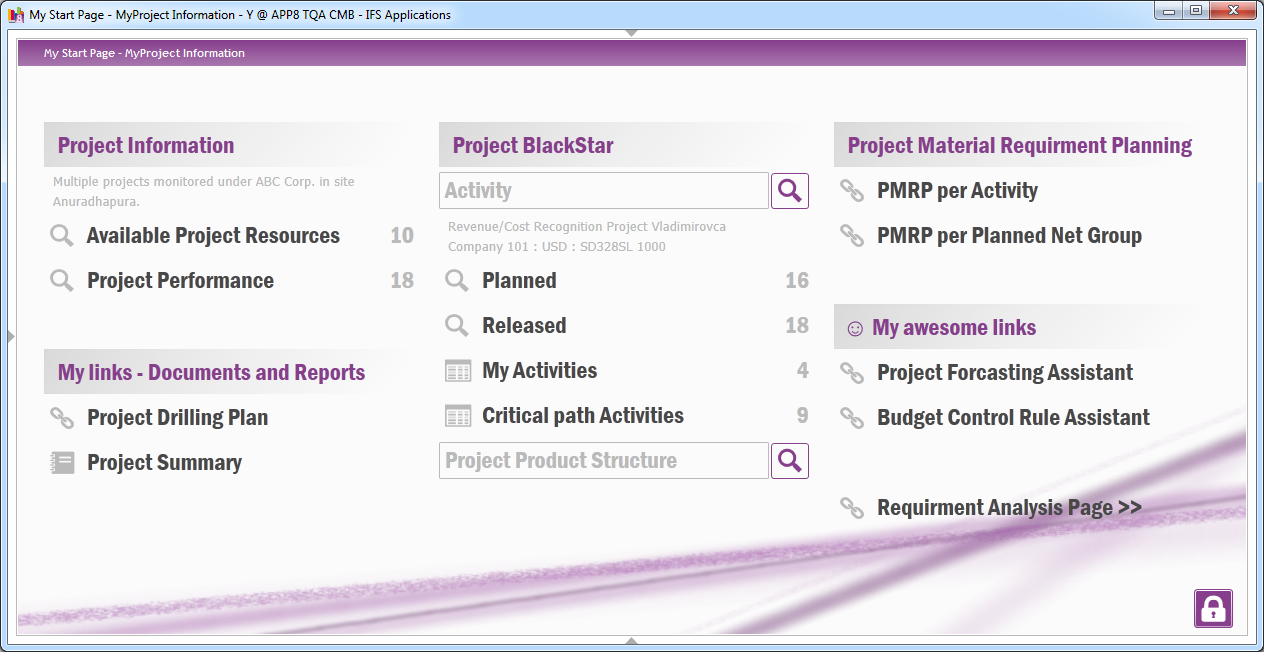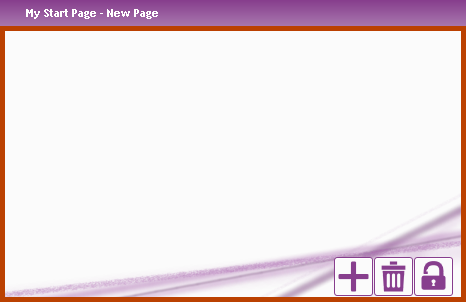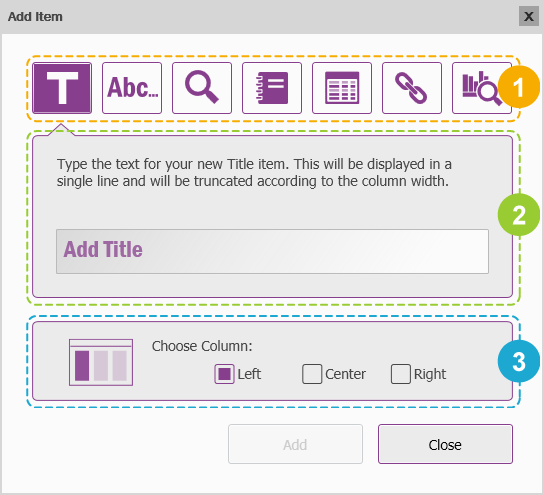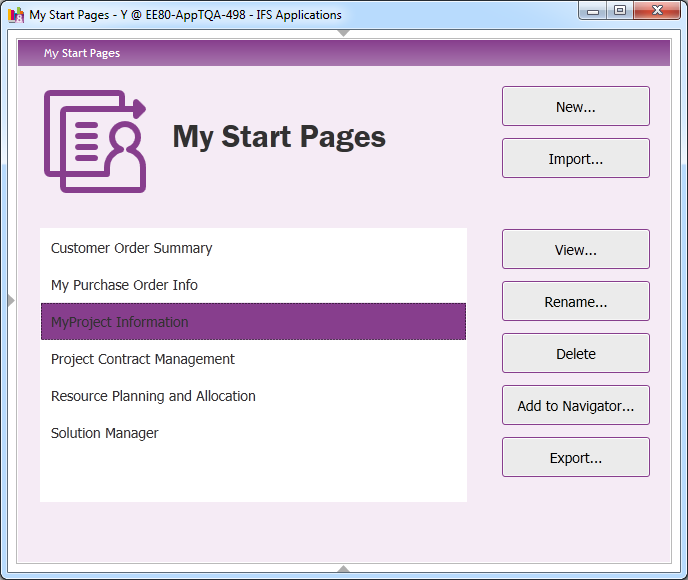
My Start Pages provide instant access to information in IFS Applications. It simplifies navigation and makes it easier to find information that is relevant for you. A My Start Page contains elements such as Saved Searches, Selections, Quick Reports, URL's and Application Search bars arranged in three columns. Titles and Notes can be used to organize your page and enhance its layout. It is also possible to have several My Start Pages.
A My Start Page can also be set as the home page for IFS Applications by setting it up in the Application Options (in the "General" tab). This will then become the entry point to the application.
My Start Pages are personal and stored in the user profile. My Start Pages can also be configured by the System Administrator and pushed out to end-users via the base profile.

Figure 1: A sample My Start Page.
The System Administrator can configure the My Start Page functionality available to the end-user by granting the appropriate permissions. Please see the Technical Documentation for further information.
N/A
Navigation Pages for IFS Enterprise Explorer
A My Start Page consists of elements arranged in three columns as shown in Figure 1. Here is an explanation of the various types of elements that are available.
| Element Icon | Explanation |
|---|---|
 |
Title |
| These elements are used to organize your page and enhance its look and feel. | |
 |
Note |
| These elements are used to organize your page and enhance its look and feel. | |
 |
Saved Search |
| These elements are connected to Saved Searches. The right end of the element shows the count result. Hover over the Saved Search element to see the IFS Applications page that it was created from. Click on the element to show the results in the IFS Applications page. | |
 |
Quick Report |
| These elements are connected to Quick Reports. Click on the element to navigate to the Quick Report's result. | |
 |
Selection |
| These elements are connected to Selections. The right end of the element shows the count of the Selection's objects. Hover over the Selection element to see the IFS Applications page that it was created from. Click on the element to show the Selection's objects in the IFS Applications page. | |
 |
Link |
| These elements are connected to an IFS Applications page, web page or file on your local computer or a network share. Hover over to see the link address. Click on the element to navigate to it. | |
 |
Application Search |
| These elements are connected to Application Search. The initial text displays the Search Domain or Search Domain Group it is connected to. This is a free-text search, so type in your query, then press Enter or click on the search button to see the results in the Application Search page. |
 |
If you are allowed to modify My Start Pages, you will see a padlock at the bottom right corner of the work area. Click on the padlock to unlock the current page so that you can make changes. |

Figure 2: An Unlocked My Start Page.
When the page is Unlocked
 |
Add New Elements |
|
Click on the Add button to open the Add Item dialog.
|
|
| Rearrange Elements | |
Click and drag elements around on your page to rearrange them. |
|
| Edit Elements | |
|
You can double click on a Title element or a Note element to edit its content. Press Enter on the keyboard to accept the modified text, or press Escape to cancel the change. In Note elements you can press Ctrl+Enter to add a new line. |
|
 |
Remove Elements |
|
When you click on the Delete button, cross-mark buttons will appear on the right edge of each element. Click on the cross button to delete the element. Deleting a Saved Search, Selection or Quick Report element will only remove the element from your page, not the actual Saved Search etc. You can always add it back if you like. When the delete setting is active, you cannot rearrange elements or click and navigate. Click on the delete button again to exit the delete setting. |
When a My Start Page is unlocked, you cannot click and navigate from an element. You also cannot unlock the same page in multiple windows at the same time. While you are in an unlocked page, if you navigate to another page in IFS Enterprise Explorer, the My Start Page will be automatically locked again. Locking a page will save the changes to the profile.

Figure 3: The Add Item dialog
The Add Item dialog consists of three main areas:
| Steps for adding a new Element | |
|---|---|
 |
Title |
| Type in the text for your new Title element. The content will display in a single line and truncate according to the column width of your page. | |
 |
Note |
| Type in the text for your new Note element. The content will wrap according to the column width of your page. To add a new line, press Ctrl+Enter. The element will display only two lines, and any remaining text can be seen by hovering the mouse over it. | |
 |
Saved Search |
| All your Saved Searches with a navigable home page will be listed in the dropdown. The
dropdown will display the Saved Search name suffixed by its home page's name. The list is sorted by the
page name to make items easy to find. The element will display the Saved
Search name along with the number of records it returns.
Note: If a Saved Search does not show up on the list, try opening the home page for that Saved Search, opening the Saved Search in the Search dialog, and saving it again under the same name. This adds some extra information that My Start Pages uses for showing the result count. |
|
 |
Quick Report |
| The dropdown will list your available Quick Reports, sorted by the report name. When you add the element to the page, it will display the Quick Report's name. | |
 |
Selection |
| The dropdown will list your available Selections. The dropdown will display the Selection name suffixed by its home page's name. The list is sorted by the page name to make items easy to find. The element will display the Selection's name and the count of objects in it. | |
 |
Link |
| Type in the title and the URL address for your new Link element. The URL can be to
an IFS Applications page, a web page or a file on your local computer or a network share.
Examples:
Hint: you could also create several My Start Pages, and link them to each other to create a multi-page My Start Page. |
|
 |
Application Search |
| The dropdown will list your available Search Domains and Search Domain Groups. Select an item to create your Application Search element. To create an element that can search in multiple domains, you must first create a Search Domain Group and select that group from the dropdown list. | |
Note: If the source of a Saved Search element or a Selection element is removed or renamed, the element would show as unavailable in your My Start Page. The below example shows what an unavailable element looks like. If you removed it, create it again with the same name. If you renamed it, either delete the element and add it again, or rename it back to the original name.

Figure 4: An example element with an unavailable item
My Start Pages is the overview page where you can manage all your My Start Pages. The page consists of a list of all your My Start Pages and a set of buttons to perform various operations.

Figure 5: The My Start Pages overview page
Here are the operations can you perform from the overview page. Note that except for New and Import, the other actions will be enabled when you select an existing page in the list.
Note: Saved Searches, Selections, Quick Reports etc. on your Exported and Imported My Start Pages rely on your access to their source. They will not work if the source is not available in the imported profile. Exporting a My Start Page does not export the source of Saved Searches, Selections or Quick reports. Application Search will also work only when the Search Domains and Domain Groups are available to the user who imports the page.